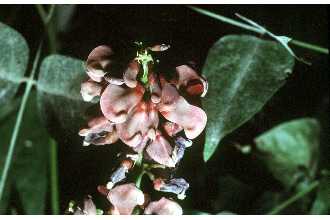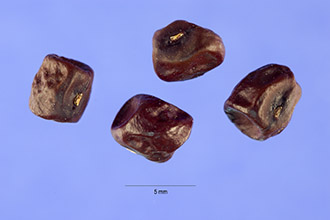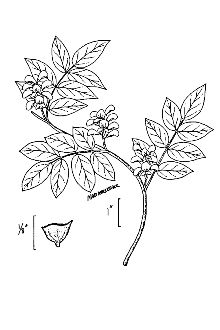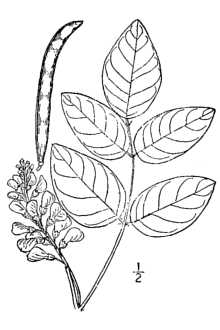Groundnut
Scientific Name: Apios americana Medik.

| General Information | |
|---|---|
| Usda Symbol | APAM |
| Group | Dicot |
| Life Cycle | Perennial |
| Growth Habits | Forb/herbVine, |
| Native Locations | APAM |
Plant Guide
Alternative Names
Groundnut, wild potato, Indian potato, wild sweet potato, American potato bean, wild bean, ground bean, hopniss, Dakota peas, sea vines, pea vines, pomme de terre, patates en chapelet, American potato bean , Use soil moisture sensors to measure the soil moisture of Groundnut.
Uses
Ethnobotanic: According to Kelly Kindscher (1987), “groundnut is a common native food plant of temperate, eastern North America. Its distribution reaches west to the wet margins of prairies, where it was once used extensively by the Native Americans.” Groundnut was a source of food among the Omaha, Dakota, Santee Sioux, Cheyenne, Osage, Pawnee, and Hidatsa (Gilmore 1913, Grinnell 1962, Matthews 1961, Wilson 1987). Groundnut was excavated from four Ozark bluff-dweller sites in Arkansas. The Ozark peoples are regarded as pre-Columbian (Beardsley 1939). Groundnuts “roots” were dug in the winter. The tubers were gathered all year but were best when harvested from late Fall through early spring. They were eaten raw, cooked, or dried and ground for flour. Some of the “roots” were boiled, peeled, and dried for storage. The seeds are cooked and eaten like peas in summer. Groundnut was also an important food of New England colonists (Hedrick 1919). Once the colonists discovered the groundnut, they enacted a town law to prevent Indians from digging groundnut on English land. Groundnut tubers are a good source of carbohydrates and contain between 13 and 17 percent protein by dry weight, or about three times more than potatoes or any other widely used vegetable root (Yanovsky and Kingsbury 1938, Watt and Merrill 1963). Horticultural: This plant is an attractive ornamental.
Status
Please consult the PLANTS Web site and your State Department of Natural Resources for this plant’s current status, such as, state noxious status, and wetland indicator values. © Jim Stasz USDA, NRCS, NPDC @ PLANTS
Description
General: Legume Family (Fabaceae). Groundnut (Apios americana) is a perennial herb from slender rhizomes with tuberous thickenings 1.3-4 cm (0.5-1.6 in) thick, and stems twining or climbing over other plants. The leaves are alternate, pinnately, egg-shaped, 2-10 cm (3/4-4 in) long, 1.8-7 cm (0.7-2.7 in) wide, and sometimes hairy. The flowers are in rounded clusters among leaves. Groundnut blooms from July to October. The flowers have 5 parts, the upper one round, white and reddish brown, the 2 side wings curved down and brown-purple, the lower 2 petals sickle-shaped and brownish red. The fruits are dry, straight or slightly curved, narrow, and 5-10 mm (3/16-3/8 in) long. The fleshy legume fruits are 6-12 mm (0.2-.5 in) in diameter and indehiscent (the fruit coils back after opening), usually with 1 seed. The seeds are oblong or square, dark brown, with wrinkled surfaces.
Distribution
For current distribution, please consult the Plant Profile page for this species on the PLANTS Web site. Groundnut is distributed through the great prairie from Quebec to Minnesota, North Dakota, south to north central Colorado, Florida, and Texas.
Establishment
Adaptation: Groundnut grows in wet meadows, low thickets, banks of streams and ponds, sloughs, moist prairie ravines, and moist soil in woodlands. Propagation from Cuttings: Plant tubers two to three inches deep in the early spring (Kindscher 1992). After shoots establishment, mulch to stop competition from weeds and grass. Provide the young shoots with a traverse or other objectives upon which to climb. After one year of growth, several one inch-thick tubers can be harvested from each plant. Because of their vining nature, groundnut would be hard to grow on a field scale, and their annual yield appears to be quite low in comparison to other crops. Groundnut is difficult to cultivate mechanically, because each tuber can sprout and grow in the spring, filling in spaces between rows.
Management
Under development. Cultivars, Improved and Selected Materials (and area of origin) APAM is available from native plant nurseries within its range.
References
Andros, F. 1883. The medicine and surgery of the Winnebago and Dakota Indians. American Medical Association Journal 1:116-118. Beardsley, G. 1939. The groundnut as used by the Indians of Eastern North America. Michigan Academy of Science, Arts, and Letters Paper 25: 507-515. Carlson, G.G. & V.H. Jones 1939. Some notes on use of plants by the Comanche Indians. Michigan Academy of Science, Arts, and Letters 25: 517-543. Densmore, F. 1974. How Indians use wild plants for food, medicine, and crafts. Dover Publications, Inc., New York, New York. 397 pp. Gilmore, M. 1913a. A study in the ethnobotany of the Omaha Indians. Nebraska State Historical Society 17: 314-357. Gilmore, M. 1913b. Some native Nebraska plants with their uses by the Dakota. Nebraska State Historical Society Proceedings and Collections 17: 358-370. Gilmore, M. 1913c. The aboriginal eography of the Nebraska country. Mississippi Valley Historical Association Proceedings 6:317-331. Gilmore, M. 1921. The ground bean and the bean mouse and their economic relations. Annals of Iowa (Series 3) 12: 606-609. Gilmore, M. 1925. The ground bean and its uses. Indian Notes 2:178-187. Grinnell, G.B. 1962. The Cheyenne Indians. 2 Vols. Cooper Square Publishers, New York, New York. Hart, J. A. 1976. Montana native plants and early peoples. Montana Historical Society, Helena, Montana. Hartmann, H.T., D.E. Kesler, & F.T. Davies, Jr. 1990. Plant propagation principles and practices. Prentice Hall. Englewood Cliffs, New Jersey. Hedrick, U.P. 1919. Sturtevant’s notes on edible plants. 27th Annual Report, Vol. 2, Part II. New York Agricultural Experiment Station. Kindscher, K. 1987. Edible wild plants of the prairie. University Press of Kansas. 276 pp. Kroeber, A.L. 1908. The ethnology of the Gros Ventre. American Museum of Natural History, Anthropological Papers 1:145-281. Martin, A.C., H.S. Zim, & A.L. Nelson. 1951. American wildlife and plants a guide to wildlife food habits. Dover Publications, Inc., New York, New York. 500 pp. Mathews, J.J. 1961. The Osages, children of the middle waters. University of Oklahoma Press, Norman, Oklahoma. McClintock, W. 1909. Materia medica of the Blackfeet. Zeitschrift fur Ethnologie: 273-279. McGregor, R.L., T.M. Barkley, R.E. Brooks, & E.K. Schofield (eds.) Flora of the Great Plains. Great Plains Flora Association. University Press of Kansas. 1402 pp. Moerman, D.E. 1986. Medicinal plants of Native America. Research Reports in Ethnobotany, Contribution 2, University of Michigan Museum of Anthropology Technical Reports, Number 19. 534 pp. USDA, NRCS 2000. The PLANTS database. <http://plants.usda.gov>. Version: 000229. National Plant Data Center, Baton Rouge, Louisiana. Watt, B.K. & A.L. Merrill 1963. Composition of foods. Agricultural Handbook 8, USDA, Washington, DC. Wilson, G.L. 1987 (1917). Buffalo bird woman’s garden. Minnesota Historical Society Press, St. Paul, Minnesota. 129 pp. Yanovsky, E. & R.M. Kingsbury 1938. Analyses of some Indian food plants. Association of Official Agricultural Chemists 21(4): 648-655.
Plant Traits
Growth Requirements
| Temperature, Minimum (°F) | -23 |
|---|---|
| Adapted to Coarse Textured Soils | Yes |
| Adapted to Fine Textured Soils | Yes |
| Adapted to Medium Textured Soils | Yes |
| Anaerobic Tolerance | High |
| CaCO3 Tolerance | High |
| Cold Stratification Required | No |
| Drought Tolerance | Low |
| Fertility Requirement | Medium |
| Fire Tolerance | Low |
| Frost Free Days, Minimum | 140 |
| Hedge Tolerance | None |
| Moisture Use | Medium |
| pH, Maximum | 7.5 |
| pH, Minimum | 6.0 |
| Planting Density per Acre, Maxim | 10000 |
| Planting Density per Acre, Minim | 2700 |
| Precipitation, Maximum | 55 |
| Precipitation, Minimum | 28 |
| Root Depth, Minimum (inches) | 8 |
| Salinity Tolerance | None |
| Shade Tolerance | Tolerant |
Morphology/Physiology
| After Harvest Regrowth Rate | Slow |
|---|---|
| Toxicity | None |
| Resprout Ability | No |
| Shape and Orientation | Climbing |
| Active Growth Period | Spring and Summer |
| Bloat | None |
| C:N Ratio | Low |
| Coppice Potential | No |
| Fall Conspicuous | No |
| Fire Resistant | No |
| Flower Color | Purple |
| Flower Conspicuous | Yes |
| Foliage Color | Green |
| Foliage Porosity Summer | Porous |
| Foliage Porosity Winter | Porous |
| Fruit/Seed Color | Brown |
| Nitrogen Fixation | Medium |
| Low Growing Grass | No |
| Lifespan | Moderate |
| Leaf Retention | No |
| Known Allelopath | No |
| Height, Mature (feet) | 1.0 |
| Growth Rate | Rapid |
| Growth Form | Single Crown |
| Fruit/Seed Conspicuous | No |
| Foliage Texture | Medium |
Reproduction
| Vegetative Spread Rate | None |
|---|---|
| Small Grain | No |
| Seedling Vigor | Medium |
| Seed Spread Rate | Slow |
| Fruit/Seed Period End | Summer |
| Propagated by Tubers | Yes |
| Propagated by Sprigs | No |
| Propagated by Sod | No |
| Propagated by Seed | Yes |
| Propagated by Cuttings | No |
| Propagated by Container | No |
| Propagated by Bulb | No |
| Propagated by Bare Root | No |
| Fruit/Seed Persistence | No |
| Fruit/Seed Period Begin | Summer |
| Fruit/Seed Abundance | Medium |
| Commercial Availability | Routinely Available |
| Bloom Period | Late Spring |
| Propagated by Corm | No |
Suitability/Use
| Veneer Product | No |
|---|---|
| Pulpwood Product | No |
| Protein Potential | Medium |
| Post Product | No |
| Palatable Human | Yes |
| Palatable Graze Animal | Medium |
| Palatable Browse Animal | Medium |
| Nursery Stock Product | No |
| Naval Store Product | No |
| Lumber Product | No |
| Fodder Product | Yes |
| Christmas Tree Product | No |
| Berry/Nut/Seed Product | No |



